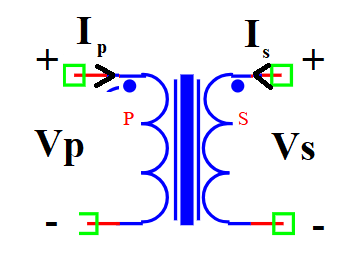Ideal Transformer
Symbol
Information

An ideal transformer is a theoretical electrical device that transfers electrical energy between two circuits without any losses. It follows the voltage and current transformation equations:
Where:
\(V_p\), \(V_s\): Primary and secondary voltage (Volts)
\(I_p\), \(I_s\): Primary and secondary current (Amperes)
\(N\): Turns ratio (dimensionless)
An ideal transformer assumes 100% efficiency, meaning there are no power losses, no leakage inductance, and no resistance in the windings.
Ports
p1, n1: Primary coil terminals
p2, n2: Secondary coil terminals
Symbol description
Field |
Value |
|---|---|
Symbol.name |
Transformer Ideal |
Symbol.file |
TransformerIdeal.sym |
Symbol.directory |
Basic |
Symbol.referance |
|
Model.name |
|
Model.file |
TransformerIdeal.py |
Model
The Ideal Transformer model implements a lossless transformer with a fixed turns ratio (N).
The voltage and current relationships are defined based on the transformation ratio, ensuring ideal energy transfer.
Attributes:
Vp (signal): Primary voltage input, defined between nodes (p1, n1).
Ip (signal): Primary current output, defined between nodes (p1, n1).
Vs (signal): Secondary voltage output, defined between nodes (p2, n2).
Is (signal): Secondary current input, defined between nodes (p2, n2).
N (param): Turns ratio (dimensionless), default is 7.0.
Methods:
analog(): Defines the ideal transformer relationship:
from pyams.lib import model, signal, param
from pyams.lib import voltage, current
class TransformerIdeal(model):
"""
Ideal Transformer Model
Defines the transformation ratio for voltage and current:
Vs = Vp / N
Ip = Is / N
"""
def __init__(self, p1, n1, p2, n2):
# Signal declaration
self.Vp = signal('in', voltage, p1, n1)
self.Ip = signal('out', current, p1, n1)
self.Vs = signal('out', voltage, p2, n2)
self.Is = signal('in', current, p2, n2)
# Parameter declaration
self.N = param(7.0, '', 'Winding ratio')
def analog(self):
"""Defines the voltage and current relationships of an ideal transformer."""
self.Vs += self.Vp / self.N # Voltage transformation equation
self.Ip += self.Is / self.N # Current transformation equation
Command syntax
The syntax for defining an Ideal Transformer in a PyAMS simulation:
# Import the model
from pyams.models import TransformerIdeal
# Tname: is the name of the Transformer instance
# p1, n1: Primary winding connections
# p2, n2: Secondary winding connections
Tname = TransformerIdeal(p1, n1, p2, n2)